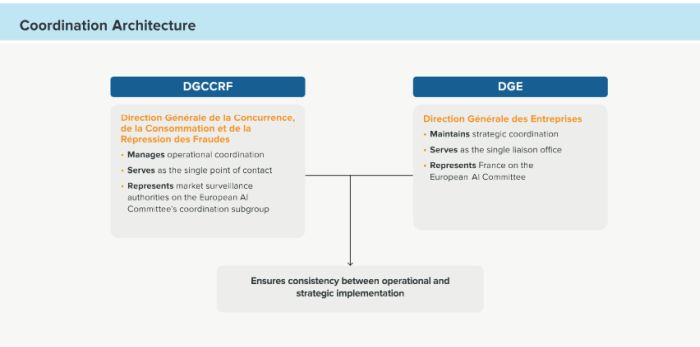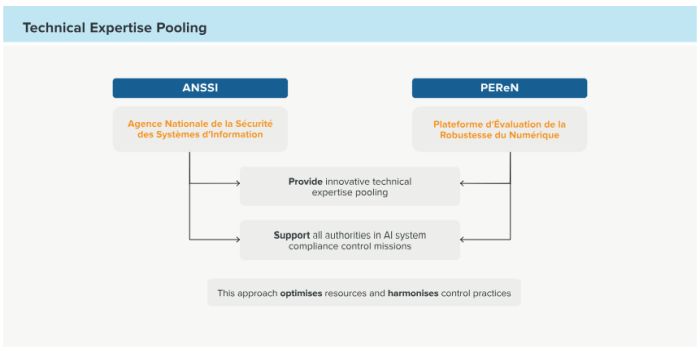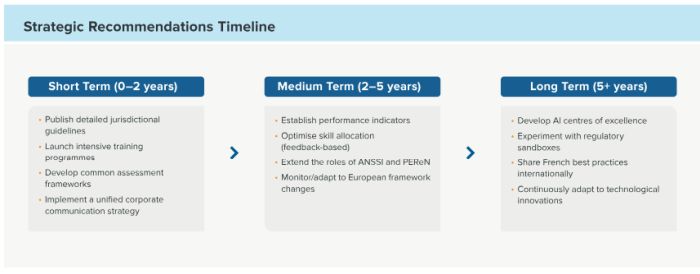- within Technology topic(s)
- with readers working within the Construction & Engineering industries
- within Transport topic(s)
Executive Summary
The French government has established a complex governance scheme for the implementation of the European Regulation (EU) 2024/1689 on artificial intelligence, structured around dual coordination: operational by the DGCCRF (Direction Générale de la Concurrence, de la Consommation et de la Répression des Fraudes), which acts as the single point of contact and represents market surveillance authorities on the AI Committee's coordination subgroup, and strategic by the DGE (Direction Générale des Entreprises), which maintains the single liaison office and represents France on the European AI Committee. This regulatory architecture divides control responsibilities between several sectoral authorities according to the nature of AI (Artificial Intelligence) systems and their areas of application, with pooled technical support provided by ANSSI (Agence Nationale de la Sécurité des Systèmes d'Information) and PEReN (Plateforme d'Évaluation de la Robustesse du Numérique) to support authorities in their compliance control missions.
Key Points
1. Coordination Architecture

2. Authority Distribution by Risk Category
Prohibited Practices: The DGCCRF and Arcom (Autorité de Régulation et de la Communication Audiovisuelle et Numérique) are responsible for monitoring manipulative techniques and the exploitation of vulnerable individuals. The DGCCRF also works together with the CNIL (Commission Nationale de l'Informatique et des Libertés) to oversee social scoring systems. Finally, the CNIL has exclusive competence for supervising criminal risk prediction, facial recognition databases, workplace emotion inference, and real-time biometric identification.
High-Risk Systems: The CNIL covers the broadest scope of supervision, including biometrics, employment, law enforcement, and border control. The ACPR (Autorité de Contrôle Prudentiel et de Résolution) is responsible for financial services, while the High Courts oversee the judicial system. The relevant ministries are in charge of critical infrastructure sectors, such as energy, transport, and health.
Transparency Obligations: The DGCCRF and Arcom share responsibility for monitoring human-AI interactions and content generation. The CNIL, for its part, has exclusive competence over emotion recognition and biometric categorisation.
3. Technical Expertise Pooling

Practical Implications
For Companies: Operators face complex regulatory mapping with multiple competent authorities per area. There is risk of divergent interpretations requiring harmonisation. The DGCCRF as single point of contact offers streamlining opportunities.
For Authorities: Each sectoral authority must rapidly develop specialised AI expertise. Robust coordination mechanisms are needed to avoid jurisdictional conflicts. Technical support from ANSSI and PEReN provides efficiency leverage.
Key Risks & Opportunities
Risks:
The French governance framework faces several implementation challenges. Regulatory fragmentation poses the most significant risk, as multiple authorities may develop divergent interpretations of AI regulation requirements, creating uncertainty for cross-sector businesses. Companies operating across multiple sectors will face particular procedural complexity, requiring them to navigate relationships with several competent authorities simultaneously. Additionally, implementation delays are anticipated as each sectoral authority must develop specialised AI expertise and establish effective coordination mechanisms.
Opportunities:
France is well-positioned to leverage its existing sectoral expertise by building upon authorities' deep industry knowledge. Such a foundation can facilitate the development of regulatory approaches that are technically sound and commercial, enabling France to become an international benchmark for AI governance, and potentially enhancing its influence in shaping European and global AI regulatory standards.
Strategic Recommendations

Conclusion
France's AI governance architecture reflects a pragmatic approach. It leverages existing sectoral expertise whilst ensuring strategic coordination. The framework's success will depend on authorities rapidly developing AI skills whilst maintaining effective inter-agency coordination. The main challenge lies in balancing sectoral specialisation with harmonised practices. France has a unique opportunity to develop an AI governance model serving as a European benchmark for AI regulation implementation.
Reference to the French governance schema
This analysis is based on the Official French governance schema (schéma de gouvernance français) established for the implementation of EU Regulation 2024/1689 on artificial intelligence, which details the distribution of competencies among French authorities for AI system oversight and compliance.
The content of this article is intended to provide a general guide to the subject matter. Specialist advice should be sought about your specific circumstances.



